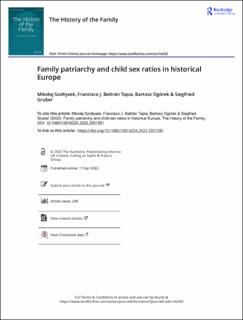| dc.contributor.author | Beltrán Tapia, Francisco Javier | |
| dc.contributor.author | Szoltysek, Mikolaj | |
| dc.contributor.author | Ogórek, Bartosz | |
| dc.contributor.author | Gruber, Siegfried | |
| dc.date.accessioned | 2022-08-08T08:37:54Z | |
| dc.date.available | 2022-08-08T08:37:54Z | |
| dc.date.created | 2022-04-29T23:14:55Z | |
| dc.date.issued | 2022 | |
| dc.identifier.issn | 1081-602X | |
| dc.identifier.uri | https://hdl.handle.net/11250/3010550 | |
| dc.description.abstract | Although recent findings suggest that gender-discriminatory practices unduly increased female mortality rates during infancy and childhood in historical Europe, especially in Southern and Eastern Europe, there is little research on the conditions that triggered these practices. Relying on child sex ratios (the number of boys per hundred girls in a particular age group) as a cumulative measure of sex-differential mortality around birth, infancy, and childhood, this article explores whether the notion of patriarchy – i.e., varying degrees of sex- and age-related social inequalities – helps to explain the variation in such discriminatory practices. For our analysis, we rely on the NAPP/Mosaic census database, which provides detailed information on more than 300 populations in historical Europe and western Siberia. Using a range of harmonised variables from the combined Mosaic and NAPP data, our results show that the Patriarchy Index, a recently developed composite measure of gendered and generational power relations in marital and family dynamics, is positively associated with child sex ratios across Europe. More specifically, we find that patrilocal norms, a low female age at marriage, and a direct measure of son preference – namely, the prevalence of having a boy as the last child – are strongly correlated with higher child sex ratios. | en_US |
| dc.language.iso | eng | en_US |
| dc.publisher | Taylor and Francis | en_US |
| dc.relation.uri | https://doi.org/10.1080/1081602X.2022.2051581 | |
| dc.rights | Attribution-NonCommercial-NoDerivatives 4.0 Internasjonal | * |
| dc.rights.uri | http://creativecommons.org/licenses/by-nc-nd/4.0/deed.no | * |
| dc.title | Family patriarchy and child sex ratios in historical Europe | en_US |
| dc.title.alternative | Family patriarchy and child sex ratios in historical Europe | en_US |
| dc.type | Journal article | en_US |
| dc.type | Peer reviewed | en_US |
| dc.description.version | publishedVersion | en_US |
| dc.source.journal | The History of the Family | en_US |
| dc.identifier.doi | https://doi.org/10.1080/1081602X.2022.2051581 | |
| dc.identifier.cristin | 2020259 | |
| dc.relation.project | Norges forskningsråd: 301527 | en_US |
| cristin.ispublished | true | |
| cristin.fulltext | original | |
| cristin.qualitycode | 1 | |

